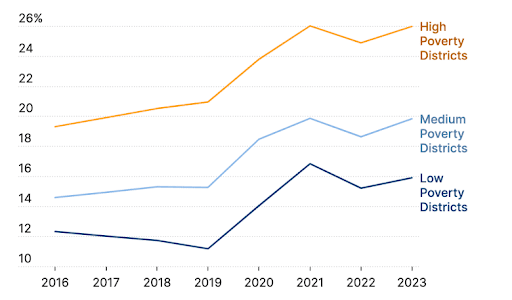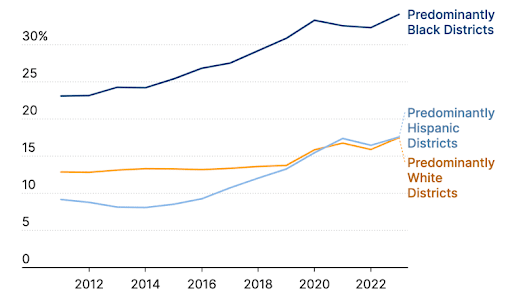Source: Brookings, “Decreasing public school registration,” August 2025
Independent school enrollment level
Before the pandemic, the share of trainees in traditional public schools held constant, floating near 85 percent in between 2016 and 2020 After the pandemic, typical public institution registration dropped to below 80 percent and hasn’t rebounded.
The mystical absent youngsters account for a big piece of the decline. Yet family members also switched over to charter and virtual institutions. Charter school registration rose from 5 percent of trainees in 2016 – 17 to 6 percent in 2023 – 24 The number of youngsters going to virtual colleges nearly increased from 0. 7 percent before the pandemic in 2019 – 20 to 1 2 percent in 2020 – 21 and has actually remained elevated.
Remarkably, private school enrollment has remained stable at almost 9 percent of school-age youngsters between 2016 – 17 and 2023 – 24, according to this Brookings price quote.
I had actually expected private school enrollment to increase, as families soured on public school interruptions during the pandemic, and as 11 states, including Arizona and Florida, released their very own instructional savings account or new voucher programs to help pay the tuition. Yet another evaluation , launched this month by researchers at Tulane University, resembled the Brookings numbers. It located that independent school registrations had actually increased by just 3 to 4 percent in between 2021 and 2024, contrasted to states without vouchers. A brand-new government tax obligation credit history to money independent school scholarships is still more than a year far from entering into impact on Jan. 1, 2027, and probably a better change right into private education is still ahead.
Defections from typical public colleges are largest in Black and high-poverty areas
I would certainly have presumed that wealthier households that can manage independent school tuition would certainly be more probable to look for options. However high-poverty districts had the largest share of pupils outside the standard public-school market. Along with private school, they were enrolled in charters, online colleges, specialized institutions for trainees with disabilities or other different institutions, or were homeschooling.
More than 1 in 4 students in high-poverty areas aren’t enlisted in a standard public institution, compared to 1 in 6 trainees in low-poverty institution districts. The steepest public college registration losses are focused in mainly Black college areas. A third of trainees in primarily Black areas are not in conventional public colleges, double the share of white and Hispanic trainees.
Share of trainee enrollment outside of typical public colleges, by district destitution

Source: Brookings, “Declining public school registration,” August 2025
Share of pupils not enlisted in typical public institutions by race and ethnicity

Resource: Brookings, “Decreasing public college registration,” August 2025
These disparities matter for the pupils that remain in traditional public institutions. Colleges in low-income and Black communities are currently losing one of the most students, compeling also steeper spending plan cuts.
The demographic timebomb
Before the pandemic, U.S. schools were already headed for a huge tightening. The average American female is now bring to life just 1 7 children over her life time, well below the 2 1 fertility price required to replace the population. Fertility prices are predicted to fall better still. The Brookings analysts think even more immigrants will certainly remain to get in the nation, in spite of current migration limitations, yet insufficient to balance out the decrease in births.
Even if family members return to their pre-pandemic registration patterns, the populace decline would certainly indicate 2 2 million less public institution students by 2050 But if moms and dads maintain selecting various other type of colleges at the rate observed since 2020, traditional public institutions can lose as several as 8 5 million pupils, shrinking from 43 06 million in 2023 – 24 to as couple of as 34 57 million by mid-century.
Between pupils gone missing out on, the options some Black family members and households in high-poverty areas are making and how many children are being born, the general public school landscape is shifting. Buckle up and prepare yourself for mass public institution closures
This tale regarding school registration decreases was generated by The Hechinger Record , a not-for-profit, independent news organization concentrated on inequality and technology in education. Sign up for Proof Information and other Hechinger newsletters